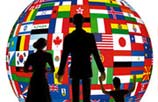Silk Road appears at the United Nations
Updated: 2014-12-17 12:32
By Niu Yue in New York(China Daily USA)
|
||||||||
 |
|
Wu Zhiyue (center), president of the Fujian Museum, speaks at a seminar about the Maritime Silk Road at Columbia University in New York on Tuesday. Lu Huiquan / for China Daily |
When mentioning the Silk Road, most people would consider the trade route from Western China to Europe through Central Asia and the Middle East. Now, dozens museums in Chinese coastal provinces are showing at the UN headquarters that there is another Silk Road on the sea with a history just as long.
Called China Maritime Silk Road Antiques Photo Exhibition, the exhibit took around three years to plan and is a joint presentation of 45 museums from China's seven costal provinces led by the Fujian Museum. It includes photos of 200 fine antiques pieces, from plates, ancient coins to glassware. There is no admission fee for the exhibition, which is open to the public until Friday. The exhibition has toured in China, Latin America, Australia and Europe before coming to New York and will go to countries in Southeastern Asia.
"Maritime Silk Road," which could date back to Han Dynasty over 2,000 years ago, is a sea trade route, from eastern China to Japan, the Korean peninsula, South Eastern Asia, India, the Middle East and Europe.
"It's an artery of communications between the East and the West in politics, culture and business," said Chen Qiuping, head of Fujian province's culture department, in a seminar on Tuesday at Columbia University. Quanzhou in Fujian, southeastern China, was regarded as the starting point of the Maritime Silk Road by the United Nations Educational, Scientific and Cultural Organization (UNESCO).
Though planned before Xi Jinping became president of China in 2013, the exhibition does reflect the central government's strategy of "One Belt and One Road," which means to build a "New Silk Road Economic Belt" and "the 21st Century Maritime Silk Road" with countries along the Silk Roads both on land and sea.
The building of the new Silk Road is expected to cover an area that includes 3 billion people and will strengthen China's ties with Asian countries. Under Xi's proposal, the Asian Infrastructure Investment Bank, described as "a new 'World Bank' for Asia" by the Economist, was founded in October 2014 and now has 21 member states.
"Our exhibition becomes more meaningful [because of the strategy]," said Wu Zhiyue, president of Fujian Museum and a major planner of the exhibition, "and we are expressing the vision in a museum way - through exhibition."
China was once a prosperous world trade center. Through the Maritime Silk Road, silk, porcelain, tea and books were exported from China to other parts of the world, while jewelry, spices and Islam came to China. Quanzhou in Fujian province was regarded as one of the largest harbors in the world, along with Alexandria of Egypt.
"It is important for everyone [to study it], because it is a forum for global exchange of art, ideas, artifacts and technology," said Katherine Anne Paul, curator, arts of Asia for the Newark Museum in New Jersey. "The Maritime Silk Road and exchanges throughout the sea are one of the most important things historically and currently."
China's sea trade dwindled in the late 14th century as the governments of Ming and Qing dynasties started to impose restrictions and bans on sea trade to prevent pirates and foreign invasion. "The 15th century is a turning point in human history. While Europe entered the Age of Discovery and started to explore the ocean, Chinese government felt imminent threat and turned inward," said Zhou Qunhua, chief of academic research at the China Maritime Museum in Shanghai.
Lu Huiquan in New York contributed to this story.
Most Viewed
Editor's Picks

|

|

|

|

|

|
Today's Top News
China, US get things done at trade talks
JD.com adds Gap clothes online
California city fights 'birth tourism'
China OKs modified corn imports
Build, not break, a bridge for people
Chinese city shops for talent in Houston
Cleaner coal goal in deal by Houston firm
China niche for California design firm
US Weekly

|

|















